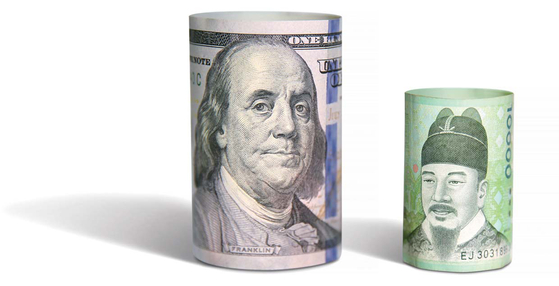The won back at crisis levels

The author, former chief economist at the Asian Development Bank and a senior adviser for international economic affairs to former President Lee Myung-bak, is a professor of economics at Korea University and president of the Korean Economic Association.
The won continues lose value against the dollar, breaking 1,390 on Wednesday. From the year-end closing of 1,190, it has increased more than 200 won. Since the 1,400-won level has only been experienced in the wake of the 1997 Asian currency crisis and 2008 global financial crisis, the revisiting is unnerving the people and suggesting another financial crisis on the horizon.
The won’s weakening owes largely to strengthening of the dollar. The dollar index against a basket of six major currencies has gained 19 percent this year to reach a 20-year high. The won has lost 20 percent against the dollar, and the yen 32 percent. The British pound and euro tumbled 17 percent, and the Chinese yuan 9 percent. The dollar becomes stronger because interest rate continues to rise in America — and because the U.S. economy is faring better than in the euro zone and China. During the annual Jackson Hole Economic Symposium on Aug. 26, Federal Reserve Chairman Jerome Powell sent the unequivocal message that the rates would continue to go up even though they would cause “some pain” to consumers and corporations. Given the unrelenting inflation, the Fed this month is expected to deliver a third consecutive 75 basis point increase or even in the full percentage point. The rate target is projected to go as high as 4 percent unless inflation falls and the economy slumps. The U.S. is relatively safe from energy and food crises, and the dollar is the most reliable reserve currency.
A strong dollar pains all countries other than America. While import prices fall for the U.S., import prices for other countries go up due to their weaker currencies, which fuels inflation in their countries. The cost of foreign debt also increases. When currency weakens for traders, price competitiveness can help exports. But when all currencies fall against the dollar, it can hardly have positive impact on exports of any single country.
The strong dollar trend will eventually end. The dollar sharply weakened in the past when global economic conditions or U.S. monetary policy changed. During the 1997 Asian liquidity crisis, the dollar index jumped from 94 at the end of 1998 to 120 in early 2002. By late 2004, it plunged to 80. No one can confidently pinpoint when the exchange rate conditions will change. But the strong dollar trend will ease when the Fed hits the brakes on rate increases.
The won is also influenced by currencies of other major trading countries like China and Japan. The won often tracks the yuan’s movement, as China is the country’s largest trading partner. China’s economy has been slowing from virus-related lockdowns, subdued demand, a real estate slump and waning productivity. The economy grew 0.4 percent on quarter in the second quarter and is expected to deliver an annual growth rate of around 3 percent. China has lowered key rate to prop up the economy, adding to the downslide of the yuan.
Japan which competes with Korean products in international markets also defies the global tightening wave and keeps its base rate in the zero territory. The yen is at its weakest since 1998. The weakening of the two largest Asian economies also have impacted the won.

The slowing economy, rising consumer prices, growing government debt, worsening current-account balance, and outflow of capital all are negative towards the Korean won. The current account balance, in particular, poses a big worry. After seasonal adjustments, the July balance showed a deficit of $1.7 billion, the first red since August 2008. The balance in the deficit means that the country earned less foreign money than before. The deterioration can add to the downside pressure for the won and stimulate speculation.
The weakening of the won stems largely from the external factors of a strong dollar, but its also reflects some domestic conditions. Companies and financial institutions must enhance risk management against volatile exchange rates. The government must examine weaknesses in the economy and endeavor to improve growth, deal with inflation and improve the fiscal and current account balances before it’s too late.
Translation by the Korea JoongAng Daily staff.










with the Korea JoongAng Daily
To write comments, please log in to one of the accounts.
Standards Board Policy (0/250자)